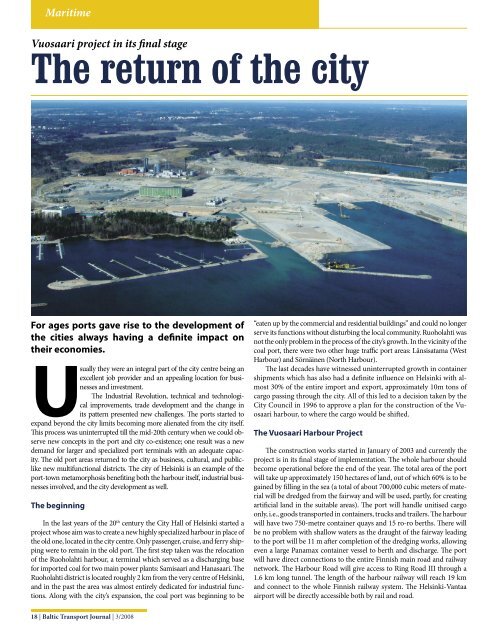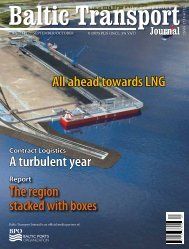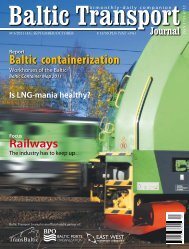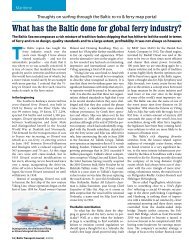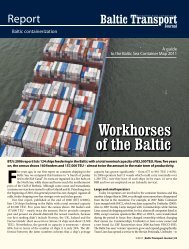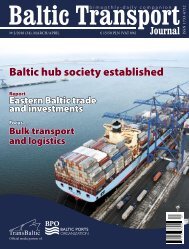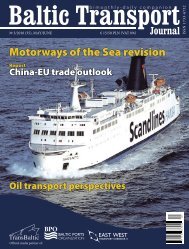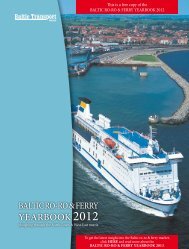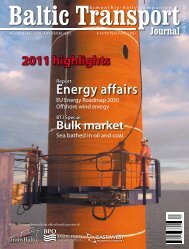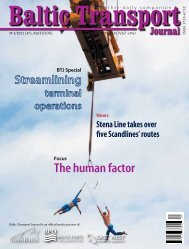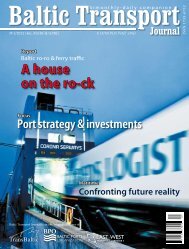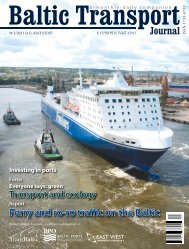You also want an ePaper? Increase the reach of your titles
YUMPU automatically turns print PDFs into web optimized ePapers that Google loves.
Maritime<br />
Vuosaari project in its final stage<br />
The return of the city<br />
For ages ports gave rise to the development of<br />
the cities always having a definite impact on<br />
their economies.<br />
Usually they were an integral part of the city centre being an<br />
excellent job provider and an appealing location for businesses<br />
and investment.<br />
The Industrial Revolution, technical and technological<br />
improvements, trade development and the change in<br />
its pattern presented new challenges. The ports started to<br />
expand beyond the city limits becoming more alienated from the city itself.<br />
This process was uninterrupted till the mid-20th century when we could observe<br />
new concepts in the port and city co-existence; one result was a new<br />
demand for larger and specialized port terminals with an adequate capacity.<br />
The old port areas returned to the city as business, cultural, and publiclike<br />
new multifunctional districts. The city of Helsinki is an example of the<br />
port-town metamorphosis benefiting both the harbour itself, industrial businesses<br />
involved, and the city development as well.<br />
The beginning<br />
In the last years of the 20 th century the City Hall of Helsinki started a<br />
project whose aim was to create a new highly specialized harbour in place of<br />
the old one, located in the city centre. Only passenger, cruise, and ferry shipping<br />
were to remain in the old port. The first step taken was the relocation<br />
of the Ruoholahti harbour, a terminal which served as a discharging base<br />
for imported coal for two main power plants: Samisaari and Hanasaari. The<br />
Ruoholahti district is located roughly 2 km from the very centre of Helsinki,<br />
and in the past the area was almost entirely dedicated for industrial functions.<br />
Along with the city’s expansion, the coal port was beginning to be<br />
18 | <strong>Baltic</strong> <strong>Transport</strong> <strong>Journal</strong> | 3/<strong>2008</strong><br />
“eaten up by the commercial and residential buildings” and could no longer<br />
serve its functions without disturbing the local community. Ruoholahti was<br />
not the only problem in the process of the city’s growth. In the vicinity of the<br />
coal port, there were two other huge traffic port areas: Länsisatama (West<br />
Harbour) and Sörnäinen (North Harbour).<br />
The last decades have witnessed uninterrupted growth in container<br />
shipments which has also had a definite influence on Helsinki with almost<br />
30% of the entire import and export, approximately 10m tons of<br />
cargo passing through the city. All of this led to a decision taken by the<br />
City Council in 1996 to approve a plan for the construction of the Vuosaari<br />
harbour, to where the cargo would be shifted.<br />
The Vuosaari Harbour Project<br />
The construction works started in January of 2003 and currently the<br />
project is in its final stage of implementation. The whole harbour should<br />
become operational before the end of the year. The total area of the port<br />
will take up approximately 150 hectares of land, out of which 60% is to be<br />
gained by filling in the sea (a total of about 700,000 cubic meters of material<br />
will be dredged from the fairway and will be used, partly, for creating<br />
artificial land in the suitable areas). The port will handle unitised cargo<br />
only, i.e., goods transported in containers, trucks and trailers. The harbour<br />
will have two 750-metre container quays and 15 ro-ro berths. There will<br />
be no problem with shallow waters as the draught of the fairway leading<br />
to the port will be 11 m after completion of the dredging works, allowing<br />
even a large Panamax container vessel to berth and discharge. The port<br />
will have direct connections to the entire Finnish main road and railway<br />
network. The Harbour Road will give access to Ring Road III through a<br />
1.6 km long tunnel. The length of the harbour railway will reach 19 km<br />
and connect to the whole Finnish railway system. The Helsinki-Vantaa<br />
airport will be directly accessible both by rail and road.


